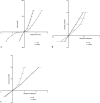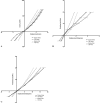What Are the Biomechanical Properties of the Taylor Spatial Frame™?
- PMID: 27896679
- PMCID: PMC5384917
- DOI: 10.1007/s11999-016-5182-8
What Are the Biomechanical Properties of the Taylor Spatial Frame™?
Abstract
Background: The Taylor Spatial Frame™ (TSF) is a versatile variant of the traditional Ilizarov circular fixator. Although in widespread use, little comparative data exist to quantify the biomechanical effect of substituting the tried-and-tested Ilizarov construct for the TSF hexapod system.
Questions/purposes: This study was designed to investigate the mechanical properties of the TSF system under physiologic loads, with and without the addition of a simulated bone model, with comparison to the standard Ilizarov frame.
Methods: The mechanical behaviors of three identical four-ring TSF and Ilizarov constructs were tested under levels of axial compression, bending, and rotational torque to simulate loading during normal gait. An acrylic-pipe fracture model subsequently was mounted, using fine wires and 5 mm half pins, and the testing was repeated. Load-deformation curves, and so rigidity, for each construct were calculated, with statistical comparisons performed using paired t-tests.
Results: Under axial loading, the TSF was found to be less rigid than the Ilizarov frame (645 ± 57 N/mm versus 1269 ± 256 N/mm; mean difference, 623 N/mm; 95% CI, 438.3-808.5 N/mm; p < 0.001), but more rigid under bending and torsional loads (bending: 42 ± 9 Nm/degree versus 78 ± 13 Nm/degree; mean difference, 37 Nm/degree; 95% CI, 25.0-47.9 Nm/degree; p < 0.001; torsion: 16 ± 2 Nm/degree versus 5 ± 0.35 Nm/degree; mean difference, 11 Nm/degree; 95% CI, 9.5-12.2 Nm/degree; p < 0.001). On mounting the bone models, these relationships broadly remained in the half-pin and fine-wire groups, however the half-pin constructs were universally more rigid than those using fine wires. This effect resulted in the TSF, using half pins, showing no difference in axial rigidity to the fine-wire Ilizarov (107 ± 3 N/mm versus 107 ± 4 N/mm; mean difference, 0.05 N/mm; 95% CI, -6.99 to 7.1 N/mm; p > 0.999), while retaining greater bending and torsional rigidity. Throughout testing, a small amount of laxity was observed in the TSF construct on either side of neutral loading, amounting to 0.72 mm (±0.37 mm) for a change in loading between -10 N and 10 N axial load, and which persisted with the addition of the synthetic fracture model.
Conclusions: This study broadly shows the TSF construct to generate lower axial rigidity, but greater bending and torsional rigidity, when compared with the Ilizarov frame, under physiologic loads. The anecdotally described laxity in the TSF hexapod strut system was shown in vitro, but only at low levels of loading around neutral. It also was shown that the increased stiffness generated by use of half pins produced a TSF construct replicating the axial rigidity of a fine-wire Ilizarov frame, for which much evidence of good clinical and radiologic outcomes exist, while providing greater rigidity and so improved resistance to potentially detrimental bending and rotational shear loads.
Clinical relevance: If replicated in the clinical setting, these findings suggest that when using the TSF, care should be taken to minimize the observed laxity around neutral with appropriate preloading of the construct, but that its use may produce constructs better able to resist bending and torsional loading, although with lower axial rigidity. Use of half pins in a TSF construct however may replicate the axial mechanical behavior of an Ilizarov construct, which is thought to be conducive to bone healing.
Figures





Comment in
-
CORR Insights®: What Are the Biomechanical Properties of the Taylor Spatial Frame™?Clin Orthop Relat Res. 2017 May;475(5):1483-1485. doi: 10.1007/s11999-016-5212-6. Epub 2017 Jan 3. Clin Orthop Relat Res. 2017. PMID: 28050821 Free PMC article. No abstract available.
References
-
- Antoci V, Voor MJ, Antoci V, Jr, Roberts CS. Biomechanics of olive wire positioning and tensioning characteristics. J Pediatr Orthop. 2005;25:798–803. doi: 10.1097/01.bpo.0000184646.03981.ec. - DOI - PubMed
-
- Binski JC. Taylor Spatial Frame in acute fracture care. Tech Orthop. 2002;17:173–184. doi: 10.1097/00013611-200206000-00007. - DOI
Publication types
MeSH terms
LinkOut - more resources
Full Text Sources
Other Literature Sources

